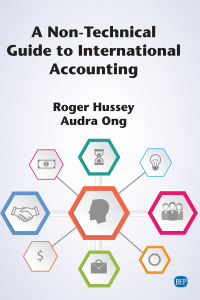Answered step by step
Verified Expert Solution
Question
1 Approved Answer
question 1-20 just the answer 1. LO 6.1 Active Frame, Inc., manufactures clear and tinted sport glasses. The manufacturing of clear glasses takes 45,000 direct
question 1-20 just the answer 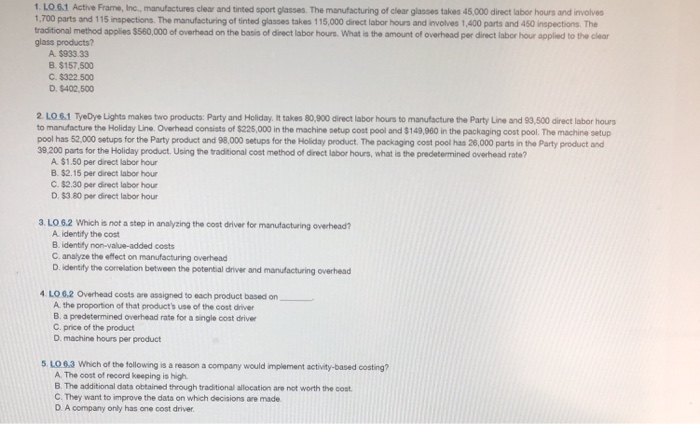
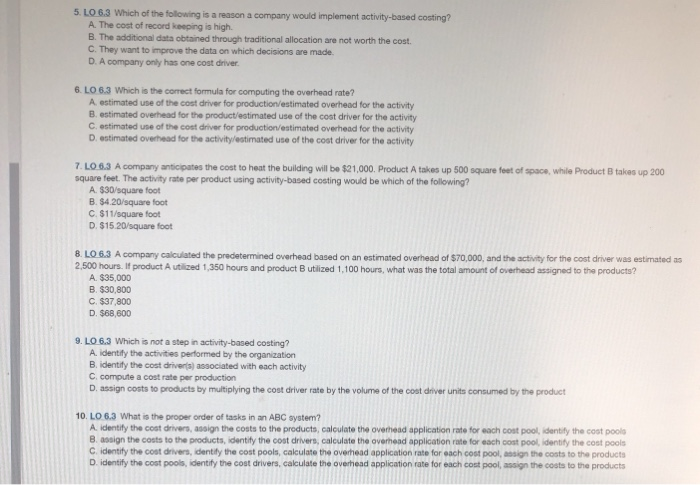
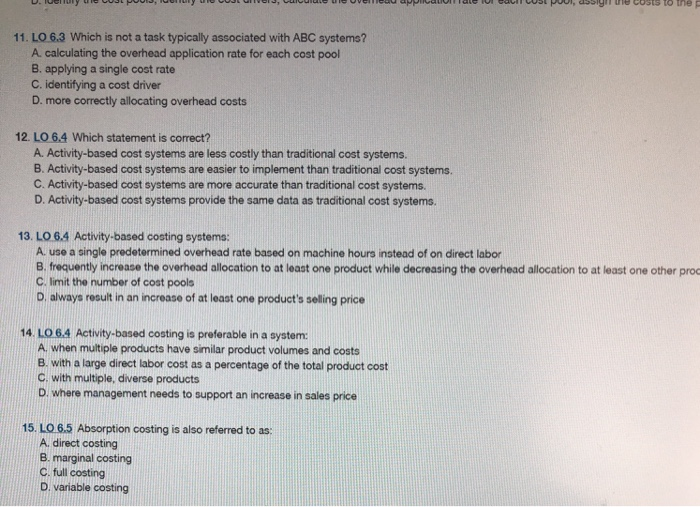
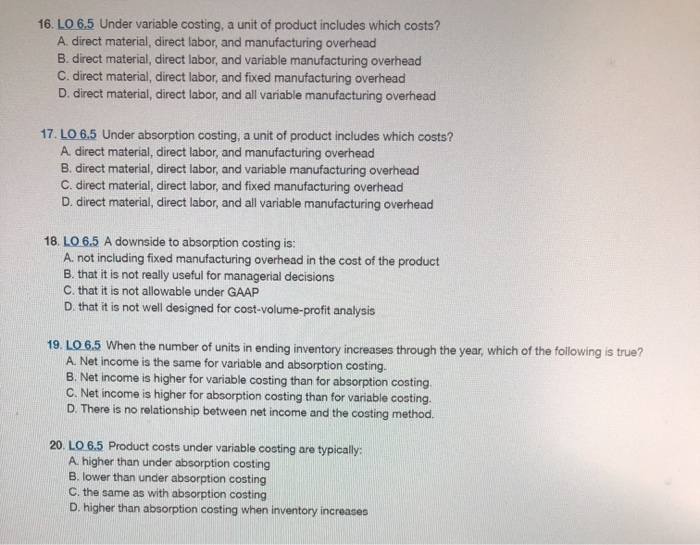
1. LO 6.1 Active Frame, Inc., manufactures clear and tinted sport glasses. The manufacturing of clear glasses takes 45,000 direct labor hours and involves 1,700 parts and 115 inspections. The manufacturing of tinted glasses takes 115,000 direct labor hours and involves 1,400 parts and 450 inspections. The traditional method applies 5560,000 of overhead on the basis of direct labor hours. What is the amount of overhead per direct labor hour applied to the clear glass products? A $933 33 B. $157,500 C. $322.500 D. 402.500 2. LO 6.1 Tye Dye Lights makes two products: Party and Holiday. It takes 80,900 direct labor hours to manufacture the Party Line and 93,500 direct labor hours to manufacture the Holiday Line Overhead consists of $225,000 in the machine setup cost pool and $149,960 in the packaging cost pool. The machine setup pool has 52,000 setups for the Party product and 98,000 setups for the Holiday product. The packaging cost pool has 20,000 parts in the Party product and 39.200 parts for the Holiday product. Using the traditional cost method of direct labor hours, what is the predetermined overhead rate? A $1.50 per direct labor hour B. $2.15 per direct labor hour C. $2.30 per direct labor hour D. $3.80 per direct labor hour 3. LO 6.2 Which is not a step in analyzing the cost driver for manufacturing overhead? A identify the cost B. identity non-value-added costs Canalyze the effect on manufacturing overhead D. Identify the correlation between the potential driver and manufacturing overhead 4. LO 6.2 Overhead costs are assigned to each product based on A. the proportion of that product's use of the cost driver B. a predetermined overhead rate for a single cost driver C. price of the product D. machine hours per product 5.LO 6.3 Which of the following is a reason a company would implement activity-based costing? A. The cost of record keeping is high B. The additional data obtained through traditional location are not worth the cost. C. They want to improve the data on which decisions are made D. A company only has one cost driver 5. LO 6.3 Which of the following is a reason a company would implement activity-based costing? A. The cost of record keeping is high B. The additional data obtained through traditional allocation are not worth the cost C. They want to improve the data on which decisions are made. D. A company only has one cost driver 6. LO 6.3 Which is the correct formula for computing the overhead rate? A estimated use of the cost driver for production/estimated overhead for the activity B. estimated overhead for the product estimated use of the cost driver for the activity C. estimated use of the cost driver for production/estimated overhead for the activity D. estimated overhead for the activity estimated use of the cost driver for the activity 7. LO 6.3 A company anticipates the cost to heat the building will be $21,000. Product A takes up 500 square foot of space, while Product B takes up 200 square feet. The activity rate per product using activity-based costing would be which of the following? A $30/square foot B. $420/square foot C. $11/square foot D. $15 20/square foot 8. LO 6.3 A company calculated the predetermined overhead based on an estimated overhead of $70,000, and the activity for the cost driver was estimated as 2.500 hours. If product A utilized 1,350 hours and product Butiized 1,100 hours, what was the total amount of overhead assigned to the products? A $35.000 B. $30.800 C. $37,800 D. $68,600 9. LO 6.3 Which is not a step in activity-based costing? A identify the activities performed by the organization B. identify the cost drivers associated with each activity C. compute a cost rate per production D. assign costs to products by multiplying the cost driver rate by the volume of the cost driver units consumed by the product 10. LO 6.3 What is the proper order of tasks in an ABC system? A identify the cost drivers, assign the costs to the products, calculate the overhead application rate for each cost pooldentify the cost poole B. assign the costs to the products, identify the cost drivers, calculate the overhead application rate for each cost pool dentity the cost pools C identify the cost drivers, dently the cost pools, calculate the overhead application rate for each cost pool, as the costs to the products D. identify the cost pools, identify the cost drivers, calculate the overhead application rate for each cost pool assign the costs to the products Uvereiro US Poi, suyu LUSIS the 11. LO 6.3 Which is not a task typically associated with ABC systems? A calculating the overhead application rate for each cost pool B. applying a single cost rate C. identifying a cost driver D. more correctly allocating overhead costs 12. LO 6.4 Which statement is correct? A. Activity-based cost systems are less costly than traditional cost systems. B. Activity-based cost systems are easier to implement than traditional cost systems. C. Activity-based cost systems are more accurate than traditional cost systems. D. Activity-based cost systems provide the same data as traditional cost systems. 13. LO 6.4 Activity-based costing systems: A. use a single predetermined overhead rate based on machine hours instead of on direct labor B. frequently increase the overhead allocation to at least one product while decreasing the overhead allocation to at least one other proc C. limit the number of cost pools D. always result in an increase of at least one product's selling price 14. LO 6.4 Activity-based costing is preferable in a system: A. When multiple products have similar product volumes and costs B. with a large direct labor cost as a percentage of the total product cost C. with multiple, diverse products D. where management needs to support an increase in sales price 15. LO 6.5 Absorption costing is also referred to as: A. direct costing B. marginal costing C. full costing D. variable costing 16. LO 6.5 Under variable costing, a unit of product includes which costs? A. direct material, direct labor, and manufacturing overhead B. direct material, direct labor, and variable manufacturing overhead C. direct material, direct labor, and fixed manufacturing overhead D. direct material, direct labor, and all variable manufacturing overhead 17. LO 6.5 Under absorption costing, a unit of product includes which costs? A direct material, direct labor, and manufacturing overhead B. direct material, direct labor, and variable manufacturing overhead C. direct material, direct labor, and fixed manufacturing overhead D. direct material, direct labor, and all variable manufacturing overhead 18. LO 6.5 A downside to absorption costing is: A. not including fixed manufacturing overhead in the cost of the product B. that it is not really useful for managerial decisions C. that it is not allowable under GAAP D. that it is not well designed for cost-volume-profit analysis 19. LO 6.5 When the number of units in onding inventory increases through the year, which of the following is true? A. Net income is the same for variable and absorption costing. B. Net income is higher for variable costing than for absorption costing C. Net income is higher for absorption costing than for variable costing D. There is no relationship between net income and the costing method. 20. LO 6.5 Product costs under variable costing are typically: A higher than under absorption costing B. lower than under absorption costing C. the same as with absorption costing D. higher than absorption costing when inventory increases 



Step by Step Solution
There are 3 Steps involved in it
Step: 1

Get Instant Access to Expert-Tailored Solutions
See step-by-step solutions with expert insights and AI powered tools for academic success
Step: 2

Step: 3

Ace Your Homework with AI
Get the answers you need in no time with our AI-driven, step-by-step assistance
Get Started


